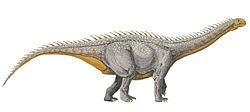Discovery and naming
In 2000, William R. Nava collected the partial skeleton of a sauropod along a road in São Paulo state near Presidente Prudente city. In 2013, a team of researchers, including Nava and led by Elaine B. Machado, described the remains as a new genus and species of sauropod, Brasilotitan nemophagus. The genus name refers to its discovery in Brazil and to the Titans of Greek mythology, and the species epithet combines the Greek words némos "pasture, wood" and phagos "to eat", in reference to its herbivorous diet. [1]
Fossil record
Fossils of Brasilotitan nemophagus are known from the Adamantina Formation, [1] although in 2017 Brusatte and colleagues suggested that some of the sauropod fossils reported from the Adamantina Formation may actually come from the Presidente Prudente Formation. [2] The holotype specimen, MPM 125R, is a partial skeleton that consists of the right dentary, two partial cervical vertebrae, a partial sacrum, two fragments of the pelvis pertaining to the ilium and ischium, and an ungual phalanx. A tooth fragment that was found nearby, MPM 126R, may belong to the same skeleton. The holotype specimen was likely scavenged by theropods before being buried, as some of the bones show puncture marks and theropod teeth were found alongside the skeleton. [1]
Phylogeny
Although the phylogenetic position of Brasilotitan is difficult to establish, the species is neither basal nor a derived member of Titanosauria. Based on lower jaw morphology, it appears to be closely related to Antarctosaurus and Bonitasaura . Its discovery enriched the titanosaur diversity of Brazil and provided further new anatomical information on the lower jaws of those herbivorous dinosaurs. [1]
Phylogenetic analyses have found Brasilotitan to be the sister taxon of another Brazilian titanosaur, Uberabatitan . [4] [5] Filippi et al. included Brasilotitan in what they called "Clade A", a grouping of titanosaurs with square jaws. [5]
This page is based on this
Wikipedia article Text is available under the
CC BY-SA 4.0 license; additional terms may apply.
Images, videos and audio are available under their respective licenses.












